
25 Things You Might Not Know About Christmas

Bethany Clarke/Dan Kitwood/Alex Wong/Michael Bradley, Getty
Christmas is full of familiar traditions: carving the ham, leaving cookies out for Santa, listening to Uncle Morty talk about his gall bladder removal surgery while you’re trying to enjoy some egg nog. These staples had to come from somewhere, and since Christmas offers a mix of religious and secular traditions, their origins are just as mixed and varied.
Everything from the Christmas tree to the marshmallows on Grandma’s yams got their start somewhere, and many have surprising stories. Take a look at a few things you might not know about Christmas below.
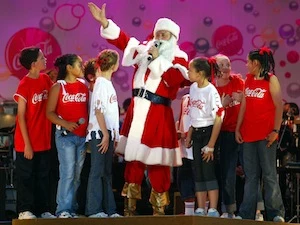
Michael Bradley, Getty
Santa Claus’ look wasn’t created by Coca-Cola
The internet age has given rise to a lot of silly, unfounded rumors about everything from Walt Disney having his head frozen to Tommy Hilfiger proclaiming on television that he didn’t want minorities wearing his clothes. Even Santa has fallen victim to this scam, despite the fact that he’s technically a non-profit. Some have claimed that Coca-Cola’s iconic portrait of Santa has shaped the way we describe him to children. In reality, he’s actually more of an “evolutionary figure” whose look has been shaped by writers, artists and even historians. Images of the familiar bearded fat man in a red suit appeared in magazines, posters and ads long before Coke’s jolly portrayal of Saint Nick.

Wikipedia
The New York Knickerbockers (the writers, not the basketball team) helped create the modern American Santa
The biggest influence on Santa’s modern look and demeanor came more from a popular group of writers who drew inspiration from an Episcopalian saint. The Knickerbockers of New York wanted to reintroduce Saint Nicholas to society to provide a “cultural counterweight for the commercial bustle and democratic misrule of early nineteenth century New York.” Contributors to the Saint Nicholas project included ‘The Legend of Sleepy Hollow’ author Washington Irving, who wrote a Christmas story about giving and generosity for his fictional ‘Bracebridge Hall’ series in which he described Santa as a large man in a red suit smoking his favorite pipe. Clement Clarke Moore, a contemporary of Irving’s, was inspired by this depiction of Santa for his “A Visit from St. Nicholas” poem, in which he also described the traditional Santa we know today.

Wikipedia
Clement Clarke Moore didn’t want ‘Twas the Night Before Christmas’ published
Also known as ‘A Visit From St. Nicholas,’ the famous Christmas poem that practically invented the modern concept of Santa almost stayed in the drawer. Moore, a 19th century author and classics professor, wrote the poem for his family to celebrate Christmas in 1922, allegedly drawing inspiration for Santa from a pudgy Dutch driver who took his family on a sleigh ride. But Moore never intended for it to be made public. In fact, a close friend of Moore’s actually sent the poem to the Sentinel newspaper, where it was published anonymously. The writer felt the poem was beneath his talents, and when it was published and became a huge hit, he denied authoring it for nearly 15 years. (It was eventually included in an anthology of Moore’s work thanks to the urging of his kids.)

Mark Wilson, Getty
Santa didn’t always have a beard
Of course, Moore and company weren’t responsible for inventing Santa, just enhancing his image. According to the book ‘One Night Stands with American History,’ 17th century Dutch settlers brought the jolly fat man to America’s shores and their image of Santa was “tall, slender and very dignified” without his trademark beard. (He was based on the traditional Dutch winter figure Sinterklaas.) Artist and political cartoonist Thomas Nast added the beard and the rotund figure in the pages of ‘Harper’s Weekly’ during the latter part of the 19th century.

Wikipedia/The Maple Leaf
NORAD’s “Santa Tracker” started from an error in a newspaper ad
The legend of Santa’s infamous sleigh ride was also perpetuated from a newspaper, but it wasn’t done intentionally. Back in 1955, a Sears ad printed the phone number of a Colorado Springs store so children could tell Santa Claus what they wanted for Christmas. The number was a misprint and instead sent children to the hotline for Colonel Harry Shoup, Director of Operations for the US Continental Air Defense. The calls poured in and instead of blocking the number, the kindly Colonel ordered his staff to give children updates on Santa’s flight coordinates. The tradition has continued to this very day on the local news, the internet and with a special “NORAD Tracks Santa” iPhone app.

Rosie Greenway, Getty
Santa’s sleigh doesn’t travel at the speed of light
Despite what you might think about Santa’s ability to visit every good boy and girl’s home in the world in one night (and if you’re over the age of 10 and still scratching your head about it, you might want to evaluate your priorities), it’s not as astronomical of a feat as you might think. Technically, Santa would have 34 hours to complete his task thanks to the International Date Line and, according to the U.S. Department of Energy’s “Fermilab,” his sleigh would only have to travel at 99.999999% of the speed of light assuming he only visits 800 million houses over the entire surface area of the Earth.
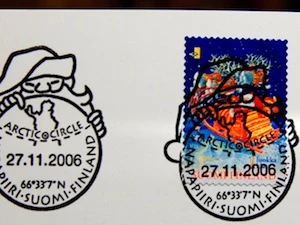
Alexander Hassenstein, Getty
Santa has a real postal zip code
Every year, post offices across America, Canada and other parts of the world are flooded with letters from kids addressed to Santa Claus. The Canadian Post Office receives so many that some postal workers started answering the letters. As the demand increased, the postal service set up a special zip code for Santa as part of their annual “Santa Letter-writing Program” literacy initiative. The zip code? H0H 0H0, of course.

Sean Gallup, Getty
Santa is the world’s richest man
He may not be in the gift giving business for the big bucks, but Santa still needs money to keep his operation rolling. (And to pay for the elves’ dental plan. Those elf unions are ruthless.) Thankfully, Santa’s wealth surpasses even Scrooge McDuck’s money bin. Forbes compiled a list of the world’s richest fictional people and St. Nick topped it with a net worth of infinity. This beats the world’s current net worth record holder, Mexican investor Carlos Slim Helu, who only topped out at a measly $74 billion. No wonder Santa’s so jolly.

Dan Kitwood, Getty
Donner and Blitzen weren’t originally part of Santa’s reindeer
The reindeer that take Santa on his trip also underwent some rebranding through history. In the original draft of ‘A Visit from St. Nicholas,’ Donner and Blitzen went by the far clunkier monikers “Dunder” and “Blixem.” The names, much like Santa, were taken from the Dutch oath for the words that mean “thunder and lightning.” Over time, editors tinkered with the reindeer names we are familiar with today. After all, it’s pretty hard to think of Rudolph as the outcast reindeer when he’s on a team with a guy named “Dunder.”
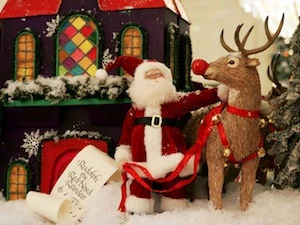
Alex Wong, Getty
‘Rudolph the Red Nose Reindeer’ was created as a promotion for Montgomery Ward
Speaking of Rudolph, the most famous of Santa’s reindeer came to life as part of a commercial promotion. His first appearance was in a story written in 1939 by ad copywriter Robert L. May that was published in a Montgomery Ward department store promotional booklet given out to children visiting Santa. Since Rudolph was created for Montgomery Ward, the department store owned the copyright and May received no royalties after it became a huge success. Sadly, May almost went bankrupt paying for his ailing wife’s medical bills before finally convincing Montgomery Ward to give him the rights to the plucky reindeer. Rudolph became an even bigger success when May set the story to music with the help of his songwriter brother-in-law Johnny Marks. A famous rendition recorded by Gene Autry became one of the best-selling Christmas songs of all time, selling more than two million copies.

Wikipedia
Jesus Christ wasn’t born on December 25
The Christian celebration of Christmas is meant to praise the birth of Jesus Christ, but churchgoers might want to check the date before they wrap up a fruit cake and put a bow on it for Our Lord and Savior. In fact, early theologians put Jesus’ birthday all over the calendar, from November 18th by one Alexandrian bishop to March 28th by the anonymous “De Pascha Computus” document found in North Africa. The truth is that the Bible doesn’t specify a date or time of Jesus’ birth. Dec. 25th was chosen in the fourth century, most likely because it was also the day of two similar pagan holidays that influenced the formation of Christmas– the birthday of Mithra and the Feast of Saturnalia.

Wikipedia
St. Nicholas is more than just the patron saint of children
The man who inspired Santa and practically the entire Christmas holiday may portray the beauty of giving and helping children in need, but Catholics in seven countries recognize him as much more than just the patron saint of kids. According to legend, the real Saint Nicholas did such good deeds as giving money to a man’s daughters so they could avoid a life of prostitution and rescuing three children from a crazy butcher. The book ‘Saints Preserved: An Encyclopedia of Relics,’ also reveals that jolly ol’ St. Nick is also the patron saint of unmarried women, prisoners, thieves and pawnbrokers. (Apparently Santa’s “naughty or nice” list was a bit more flexible back in the day.)
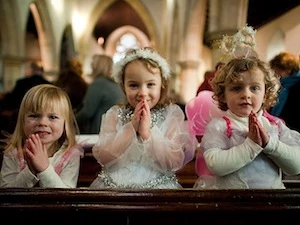
Bethany Clarke, Getty
‘Xmas’ doesn’t remove Christ from ‘Christmas’
Many publications and ads like to print the innocuous sounding ‘Xmas’ to prevent them from scaring away any non-Christian customers. But if they knew the true origin for the word, they’d probably opt for the full version and call it a day. According to ‘From Adam’s Apple to Xmas: An Essential Vocabulary Guide for the Politically Correct,’ the word “Christianity” was spelled “Xianity” as far back as 1100 as a symbolic syllable for “Christ.” The syllable became ‘X’temmas’ in 1551 and was eventually shortened to “Xmas.”
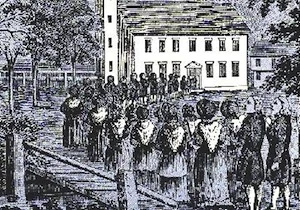
Boston University
Massachusetts Puritans actually banned Christmas by law
Cable news networks love to roll out stories about the neverending “War on Christmas” by showing how businesses and governments are trying to be politically correct by referring to the Christmas season as “the holidays.” But there was one group who nearly did what The Grinch failed to accomplish — they stopped Christmas from coming. The early American Puritans of Massachusetts enacted a law in 1659 that made it illegal to celebrate Christmas since Puritans didn’t believe it to be the true date of their savior’s birth. The law carried a punishment of five shillings.
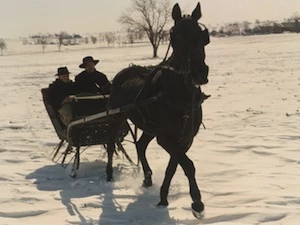
Three Lions, Getty
‘Jingle Bells’ was written for Thanksgiving, not Christmas
It’s hard to go more than five minutes without hearing the familiar tune of ‘Jingle Bells’ running through your head during the month of December. The truth is that you should have been hearing it in November. According to Mental_Floss Magazine, composer James Lord Pierpont wrote the song in the 1850s to play for his Boston Sunday school class during Thanksgiving as a way to commemorate the famed Medford sleigh races. Kids and adults loved the song and eventually changed the lyrics to fit Christmas. No word on whether the original lyrics contained the line, “Dashing through the snow, in a one-turkey open sleigh.”

Wikipedia
The man who wrote the melody for ‘O Holy Night’ was Jewish.
While the Christmas classic ‘O Holy Night’ may have heavy Christian overtones, one of the men who brought it to fruition and helped spread its popularity was actually a member of the Jewish faith. The lyrics for the song were written in 1847 by Placide Cappeau de Roquemaure in France after a parish priest asked him to pen a song for his Christmas mass. The wine merchant wasn’t a noted churchgoer, but he was a poet of some renown and was happy to help with a tune. ‘Cantique de Noel’ needed a melody and he turned to his friend, composer Adolphe Charles Adams who wrote operas and became famous for his ballet interpretation of ‘Faust.’ The song became a hit with the church, but when leaders discovered Adams’ Jewish faith, they denounced the song and deemed it unfit for its “total absence of the spirit of religion.”
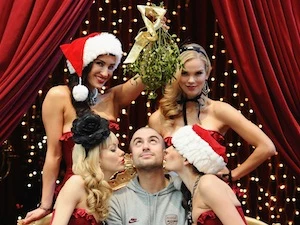
Ian Gavan, Getty
Mistletoe was once believed to be an aphrodisiac
Everyone hopes they’ll be able to steal a kiss from underneath this staple of holiday flora, but some hoped it would help them get a whole lot more. The poisonous fruit bearing plant has long been a symbol of virility and fertility, but the Druids actually believed it worked as a physical aphrodisiac. The spirited use of the plant gathered during the winter solstice eventually led to the kissing tradition that continues to make drunken office holiday parties extremely awkward the world over.

Christopher Furlong, Getty
“Mistletoe” has a strange meaning in the Germanic language
Of course, if you knew what the name “mistletoe” actually meant, you’d be less inclined to stand under it. The quasi-parasitic plant has a “symbiotic relationship” with a bird called the mistle thrush. The bird eats the berries, digests the seeds and then leaves droppings which eventually grow into new mistletoe plants. Which explains why the Germanic word for “mistletoe” literally means “dung on a twig.”

Samir Hussein, Getty
Buying the gifts from the ’12 Days of Christmas’ will cost you
Sure, things like “Lords ‘a leaping” and “maids ‘a milking” might not sound like the most exciting gifts once could receive. But if you knew the price tag, you’d immediately regret the lousy gift cards you got for your loved ones. Every year around the holidays, PNC Wealth Management calculates the costs of the gifts in the song. The price index for the gifts in the ’12 Days of Christmas’ went from $12,673 in 1984 to more than $24,000 for 2011. The most expensive gift is the “Swans ‘a swimming,” valued this year at $6,300. That’s not including the medical bills you’d incur trying to wrangle said swans.

ChinaFotoPress, Getty
One of the first commercially sold artificial Christmas trees was made from toilet brushes
Artificial Christmas trees might be seen as tacky, modern takes on the classic Douglas-fir, but they are actually much older than you might think. The oldest fake trees date back to 1886 in London and were made out of green raffia, the twine that is more commonly used to make grass hula skirts. Other varieties were made in the latter part of the 19th century in Germany and used tabletop feathers from geese that were dyed pine-green. Then the Addis Brush Company used their toilet brush weaving machinery to create pine-like branches for their fake Christmas trees. They were less flammable, held heavier decorations and could make your toilet bowl sparkling clean.

Sean Gallup, Getty
Candy canes used to be “pure white”
Few things say Christmas more than those sugary sticks of red and white deliciousness. There was a time, however, when they weren’t red and white.(Although we imagine they were still pretty tasty.) The familiar Christmas treats started popping up around the 17th century as Europeans started using trees to celebrate the Christian holiday season and made special foods to decorate them with. Candy canes first appeared around 1670 when a cathedral choirmaster would hand out the all-white confections to children to keep them occupied during Christmas mass. While no one knows exactly who gave candy canes their stripes, one (unproven) theory has it that the “J” shape was once meant to stand for Jesus and the three stripes represent the Holy Trinity. (Red is meant to represent the blood of Christ. Chew over that the next time you bite into a tasty candy cane.)

Wikipedia
Teddy Roosevelt banned Christmas trees at the White House
Today, the White House’s annual Christmas tree lighting is a hallowed tradition. But try telling that to Teddy Roosevelt, who didn’t think the event was very majestic. In fact, he found it so infuriating that he enacted a total ban on putting up a tree in the White House during his term. In fact, in 1902, Roosevelt’s son Archie snuck his own Christmas tree into the house which he hid in a closet. Was the 26th President a Scrooge? Nope, just an avid outdoorsmen and conservationist who found deforestation revolting.
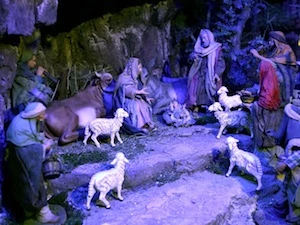
Vittorio Zunino Celotto, Getty
Jesus was actually born in a cave
The familiar scene of a manger filled with animals as the baby Jesus enters the world pops up in front of every church even before Christmas has a chance to start. However, it’s more likely that Jesus came into the world from a cave. According to the gospel of Luke, the shepherds that helped find shelter for Mary to give birth kept their flock in a cave. The Church of the Nativity in Bethlehem is built over the cave (dubbed “The Grotto of the Nativity”) where Jesus is believed to have been born.
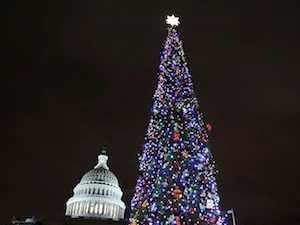
Alex Wong, Getty
Christmas wasn’t an official holiday in America until 1870
The holiday might seem like an ancient tradition steeped in history, but it’s much younger than you might think. Christmas didn’t became an official federal holiday until June 26, 1870. The holiday mostly got its start in Pagan roots as an excuse for drunken revelry, which wasn’t appealing to the strict Christian Puritans. Early in America’s birth, some states started recognizing Christmas and a lobby started for a national holiday for Thanksgiving and Christmas to strengthen the nation’s unity.

Wikipedia
Iceland has 13 Santas including one that kidnaps children
If you thought making children believe in one Santa was hard enough, be thankful you don’t live in Iceland. Their Christmas tradition has 13 “Yuletide Lads” who either leave presents or pull pranks for children during the 26 day holiday season as a reward or punishment for their behavior. For instance, Grýla is a horrifying old woman who kidnaps children on Christmas if they have been naughty. Though technically that’s really more of a present for the parents.
More From K96 FM



![Whatever Happened to ‘90210′ Star Jamie Walters? [PHOTO]](http://townsquare.media/site/110/files/2011/12/jamie-walters-myspace.jpg?w=980&q=75)


![What Did President Barack Obama Buy on His Holiday Shopping Trip? [PHOTOS]](http://townsquare.media/site/110/files/2011/12/obama-shops-best-buy-petsmart.jpg?w=980&q=75)
![Will the Christmas Staple Frankincense Soon Be Gone? [VIDEO]](http://townsquare.media/site/110/files/2011/12/Frankincense.jpg?w=980&q=75)

